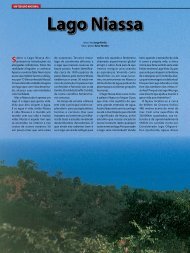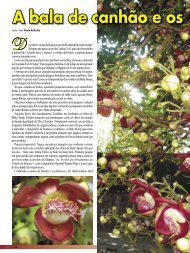Os leões que protegem um novo edifício chinês, na baixa de ... - LAM
Os leões que protegem um novo edifício chinês, na baixa de ... - LAM
Os leões que protegem um novo edifício chinês, na baixa de ... - LAM
Create successful ePaper yourself
Turn your PDF publications into a flip-book with our unique Google optimized e-Paper software.
Por isso foi obrigado a fugir da sua al<strong>de</strong>ia. Para viver, ia vagueando e aceitando<br />
trabalhos h<strong>um</strong>il<strong>de</strong>s. Um dia, n<strong>um</strong>a tasca, encontrou dois jovens, Liu<br />
Pei e Chang Fei, <strong>que</strong>, como ele, não tinham abrigo nem emprego. A lenda<br />
conta <strong>que</strong>, <strong>na</strong><strong>que</strong>le mesmo dia, n<strong>um</strong> pomar <strong>de</strong> pessegueiros em flor, selaram<br />
<strong>um</strong> pacto <strong>de</strong> ter<strong>na</strong> irmanda<strong>de</strong>. Acabariam recrutados pelo governo para<br />
suprimir a revolta dos “turbantes amarelos”. Chefiando <strong>um</strong> grupo <strong>de</strong> 300<br />
homens conseguiram <strong>de</strong>rrotar os rebel<strong>de</strong>s, começando assim a sua cruzada<br />
para juntar o fragmentado império <strong>chinês</strong>. Durante as várias guerras, Kuan<br />
Ti distinguiu-se como <strong>um</strong> Robin Hood, lutando por causas justas contra os<br />
opressores. Tinha <strong>um</strong> génio militar muito apurado e a sua arma, o kwon do,<br />
ficou famosa.<br />
Kuan Ti tornou-se o símbolo <strong>de</strong> lealda<strong>de</strong>, justiça e h<strong>um</strong>ilda<strong>de</strong>. Ao longo<br />
dos tempos foi feito du<strong>que</strong>, príncipe guerreiro e, fi<strong>na</strong>lmente em 1594, o<br />
Imperador Ming Wan Li conferiu-lhe o título <strong>de</strong> Gran<strong>de</strong> Deida<strong>de</strong> Fiel<br />
48<br />
a quadrangular building ma<strong>de</strong> of wood and zinc without any Chinese<br />
architectural characteristics…” It was, in fact, not <strong>de</strong>dicated to the Buddha<br />
but to another <strong>de</strong>ity, Kuan Ti.<br />
Kuan Ti is still today one of the most powerful and worshipped Chinese<br />
<strong>de</strong>ities. He was a great warrior, a historical figure who was born in Chi<strong>na</strong> in<br />
162 AC, at the time of the collapse of the Han Dy<strong>na</strong>sty, and was behea<strong>de</strong>d<br />
at 58 years of age. The story of his life became one of the classic works of<br />
Chinese literature, The Romance of the Three Kingdoms.<br />
The mythical aura created around Kuan Ti may be compared to that of Shaka<br />
Zulu, the medieval European knights or the English hero Robin Hood.<br />
It was thus that the story of Kuan Ti became intertwined with the history of<br />
Mozambi<strong>que</strong>. And it is not a heresy at all.<br />
The large statue of the warrior, god of war and guardian of the martial arts,<br />
stands in the basement of the Art Muse<strong>um</strong> in Maputo since the <strong>na</strong>tio<strong>na</strong>lizations<br />
of 1975. It used to be situated in the altar of the Chinese School, the current seat<br />
of the Natio<strong>na</strong>l Institute of Visual Arts. It eschewed the rampant appropriation<br />
of the furniture that <strong>de</strong>corated the halls.<br />
The altar was “officially” han<strong>de</strong>d over to the Association of the Chinese<br />
Community of Mozambi<strong>que</strong>, but in reality this was never fulfilled. The<br />
Association has still not retaken possession of its old headquarters as had been<br />
promised at an official ceremony in 2005.<br />
Kuan Ti was raised by his mother. When he was a young man, in or<strong>de</strong>r to<br />
<strong>de</strong>fend his weaker fellow citizens, he slew a wicked and very powerful man<br />
and was thus forced to flee from his village. In or<strong>de</strong>r to survive, he wan<strong>de</strong>red<br />
about and accepted mo<strong>de</strong>st jobs. One day, in a tavern, Kuan Ti met two<br />
youths, Liu Pei and Chang Fei, who, like him, had neither shelter nor work.<br />
According to the legend, on that same day, the three youths swore to an oath<br />
of eter<strong>na</strong>l friendship in a gar<strong>de</strong>n of peach blossoms. They were recruited by<br />
the government to suppress the Yellow Turban Rebellion. Leading an army of<br />
300 men, they ma<strong>na</strong>ged to <strong>de</strong>feat the rebels, thus embarking on a mission<br />
to unite the fragmented Chinese Empire. Throughout the various wars, Kuan









